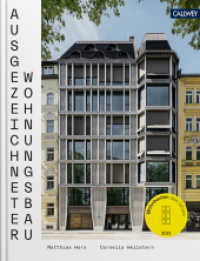- ホーム
- > 洋書
- > ドイツ書
- > Humanities, Arts & Music
- > History
- > antiquity
Description
(Short description)
(Text)
(Short description)
Resafa - Sergiupolis, the later Rusafat Hisham, is an exemplary site for an exemplary exploration. On the site of a late Roman limes fort (3rd century), a magnificent pilgrimage site to the tomb of St. Sergios (5th/6th century) developed, which was then elevated by the great caliph Hisham to his residence (8th century). On the basis of the research carried out until 2011, a panorama of the transformation is drawn up: Divided into 14 phases of urban development, from the 1st century AD to our own time, this is presented vividly for the first time in the form of a reference work, based on a large number of large-size color maps as well as serial 3D model renderings.
(Text)
In Resafa - Sergiupolis/Rusafat Hisam, like in hardly any other late antique-early Islamic city, transformation processes within and between its formative cultures can be traced. The history of the site is as rich as the contexts that allowed a Limes fort to become first a pilgrimage city and then a caliph's residence are complex. After one hundred years of research, the scientific results are highly multilayered and difficult to comprehend. This is precisely where this atlas comes in, by presenting the history and development of the site for the first time in clearly structured 14 phases of urban construction. In the first part, large-scale plans are used to break down the processes of change in the city and its environs, and in the second part, the development of its major monuments is traced on the basis of those overarching phases. Important stages are the martyrdom of St Sergius (around 312) at the gates of the late Roman Limes fort, the expansion of this military nucleus into a splendid pilgrimage city (sixth century), place caliph Hisam b. Abd al-Malik (c. 105/724) chose as residence, and the role of the city after the transfer of central power under the Abbasids (8th/9th c.) up to the abandonment of the settlement under the Mamluks (7th/13th c.). The period covered ends in 2011 with the beginning of the Syrian civil war.








